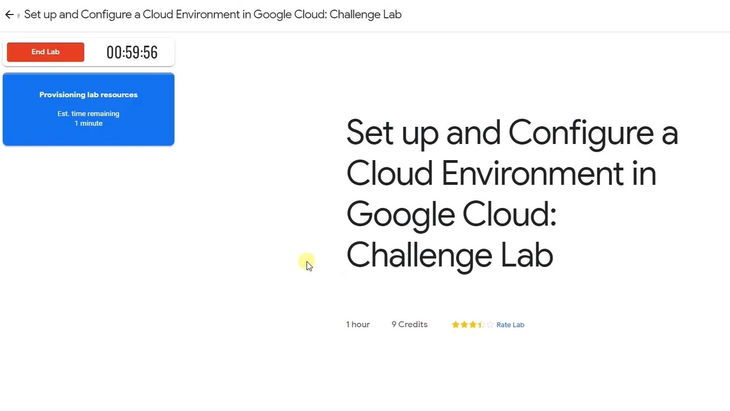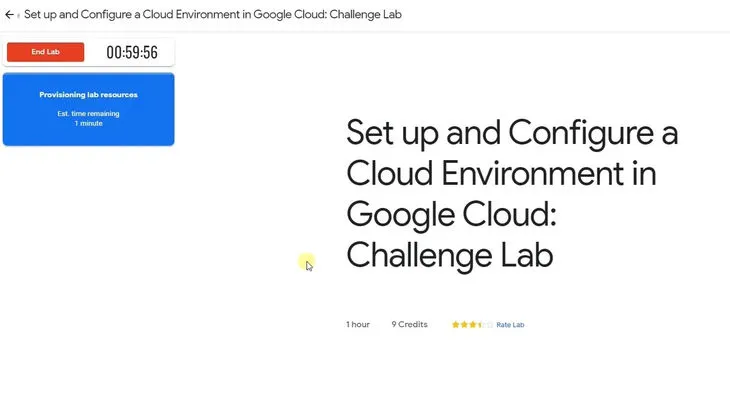☁ Set up and Configure a Cloud Environment in Google Cloud: Challenge Lab | logbook


In this article, we will go through the lab GSP321 Set up and Configure a Cloud Environment in Google Cloud: Challenge Lab, which is an expert-level exercise on Qwiklabs. You will practice the skills and knowledge to deploy VPCs for development and production, a Kubernetes cluster, and a Cloud SQL instance for a WordPress site.
The challenge contains 9 required tasks:
- Create development VPC manually
- Create production VPC using Deployment Manager
- Create bastion host
- Create and configure Cloud SQL Instance
- Create Kubernetes cluster
- Prepare the Kubernetes cluster
- Create a WordPress deployment
- Enable monitoring
- Provide access for an additional engineer
Task 1: Create development VPC manually
Make sure you create all resources in the us-east1 region and us-east1-b zone.
- In the Google Cloud Console, navigate to VPC network > VPC networks
- Click on Create VPC network.
- Enter
griffin-dev-vpcto the Name field. - Select Custom for the Subnet creation mode.
-
Add
griffin-dev-wpsubnet with the following parameters:Field Value Name: griffin-dev-wpRegion: us-east1IP address range: 192.168.16.0/20 -
Click + Add subnet and add
griffin-dev-mgmtsubnet with the following parametersField Value Name: griffin-dev-mgmtRegion: us-east1IP address range: 192.168.32.0/20 - Click Create.
Task 2: Create production VPC using Deployment Manager
-
Copy the Deployment Manager configuration files to Cloud Shell using the following command:
gsutil cp -r gs://cloud-training/gsp321/dm ~/ -
Edit
prod-network.yamlconfiguration filecd dm edit prod-network.yaml -
Replace
SET_REGIONwithus-east1in the editor, and then save the change. -
Go back to the Cloud Shell, use the following command to create the production VPC network with the configuration files:
gcloud deployment-manager deployments create griffin-prod --config prod-network.yaml -
Go back to the Cloud Console, navigate to Deployment Manager to confirm the deployment.
Task 3: Create bastion host
- In the Cloud Console, navigate to Compute Engine > VM instances.
- Click Create.
-
Use the following parameters to create the bastion host:
Field Value Name: griffin-dev-dbRegion: us-east1 - Expand the Management, security, disks, networking, sole tenancy section.
- In the Networking tab, add
bastionto the Network tags. -
Click Add network interface, make sure that you set up two Network interfaces,
griffin-dev-mgmtgriffin-prod-mgmt
- Click Create.
- Navigate to VPC network > Firewall.
- Click CREATE FIREWALL RULE.
-
Configure the rule with the following parameters:
Field Value Name: allow-bastion-dev-sshNetwork: griffin-dev-vpcTargets: bastionSource IP ranges: 192.168.32.0/20Protocols and ports: tcp: 22 - Click CREATE.
- Click CREATE FIREWALL RULE again.
-
Configure another rule with the following parameters:
Field Value Name: allow-bastion-prod-sshNetwork: griffin-prod-vpcTargets: bastionSource IP ranges: 192.168.48.0/20Protocols and ports: tcp: 22 - Click CREATE.
Task 4: Create and configure Cloud SQL Instance
- In the Cloud Console, navigate to SQL.
- Click CREATE INSTANCE.
- Click Choose MySQL.
-
Use the following parameters to create the instance:
Field Value Name: griffin-dev-dbRegion: us-east1Zone: us-east1-bRoot password: e.g. 12345678Note: In real practice, you must set a strong password.
- Click Create.
- Click the
griffin-dev-dbin the SQL pane after it has been created. - Under Connect to this instance, click on Connect using Cloud Shell.
-
Go back to the Cloud Shell, run:
gcloud sql connect griffin-dev-db --user=root --quiet - Enter the Root password generated in Step 4.
-
In the SQL console, run the following query to create the wordpress database:
CREATE DATABASE wordpress; GRANT ALL PRIVILEGES ON wordpress.* TO "wp_user"@"%" IDENTIFIED BY "stormwind_rules"; FLUSH PRIVILEGES; - Enter
exitto quit the SQL shell.
Task 5: Create Kubernetes cluster
Create a 2 node cluster (n1-standard-4) called griffin-dev, in the griffin-dev-wp subnet, and in the zone us-east1-b.
- In the Cloud Console, navigate to Kubernetes Engine > Clusters.
- Click Create cluster.
-
In the Cluster basics tab, configure:
- Name:
griffin-dev - Zone:
us-east1-b
- Name:
-
In the left pane, click default-pool under NODE POOLS and set
- Number of nodes:
2
- Number of nodes:
-
Click Nodes Under default-pool, and set
- Machine type:
n1-standard-4
- Machine type:
-
Go to the Network tab, set
- Network:
griffin-dev-vpc - Node subnet:
griffin-dev-wp
- Network:
- Click CREATE.
Task 6: Prepare the Kubernetes cluster
-
In the Cloud Shell, use the following command to copy the files for the Kubernetes:
gsutil cp -r gs://cloud-training/gsp321/wp-k8s ~/ -
Open
wp-k8s/wp-env.yamlwith the Cloud Shell Editor.cd ~/wp-k8s edit wp-env.yaml - Replace
username_goes_hereandpassword_goes_heretowp_userandstormwind_rules, respectively. - Save the file change.
- After the Kubernetes cluster has been created, click on the Connect button.
-
Run the following command to connect the cluster:
gcloud container clusters get-credentials griffin-dev --zone=us-east1 -
Deploy the configuration to the cluster using:
kubectl apply -f wp-env.yaml -
Use the command below to create the key, and then add the key to the Kubernetes environment:
gcloud iam service-accounts keys create key.json \ --iam-account=cloud-sql-proxy@$GOOGLE_CLOUD_PROJECT.iam.gserviceaccount.com kubectl create secret generic cloudsql-instance-credentials \ --from-file key.json
Task 7: Create a WordPress deployment
-
Open
wp-k8s/wp-deployment.yamlwith the Cloud Shell Editorcd ~/wp-k8s edit wp-deployment.yaml -
Replace
YOUR_SQL_INSTANCEwithgriffin-dev-db’s Instance connection name. - Save the file change.
-
Go back to the Cloud Shell, run the following commands:
kubectl create -f wp-deployment.yaml kubectl create -f wp-service.yaml -
Copy the External endpoints of the deployed wordpress service and open it in your browser.
Task 8: Enable monitoring
- Go back to the Cloud Console, and navigate to Monitoring.
- In the Monitoring console, click Uptime checks in the left pane.
- Click CREATE UPTIME CHECK.
-
Configure using the following parameters:
Field Value Title WordPress UptimeCheck Type HTTPResource Type URLHostname YOUR-WORDPRESS_ENDPOINTPath / - Click TEST.
- Click SAVE if there is no error.
Task 9: Provide access for an additional engineer
- In the Cloud Console, navigate to IAM & Admin > IAM.
- Click +ADD.
- In the Add members to … pane, copy and paste the second user account for the lab to the New members field.
- In the Role dropdown, select Project > Editor.
- Click SAVE.
Congratulations! You completed this challenge lab.
Demonstration Video
This browser does not support the YouTube video player. Watch on YouTube
⏱Timestamps:
00:00 Lab start and provisioning
01:06 Create development VPC manually
02:50 Create production VPC using Deployment Manager
07:29 Create a bastion host
08:43 Create the firewall rule to enable SSH connection to the bastion host
11:33 Create a MySQL Cloud SQL Instance
13:03 Create a Kubernetes cluster
15:04 Create the worpdress database
17:03 Prepare the Kubernetes cluster
20:15 Create a WordPress deployment
23:34 Create an uptime check for the WordPress development site.
25:04 Provide access for an additional engineer
Keep on reading:
- ☁ Secure Workloads in Google Kubernetes Engine: Challenge Lab | logbook
- ☁ Build and Secure Networks in Google Cloud: Challenge Lab | logbook
- ☁ Deploy to Kubernetes in Google Cloud: Challenge Lab | logbook
- ☁ Build a Website on Google Cloud: Challenge Lab | logbook
- ☁ Migrate a MySQL Database to Google Cloud SQL | logbook
Useful external link: